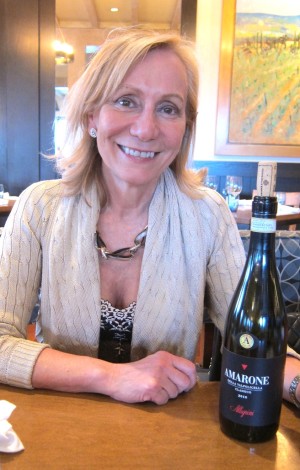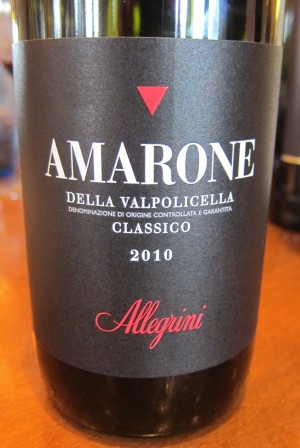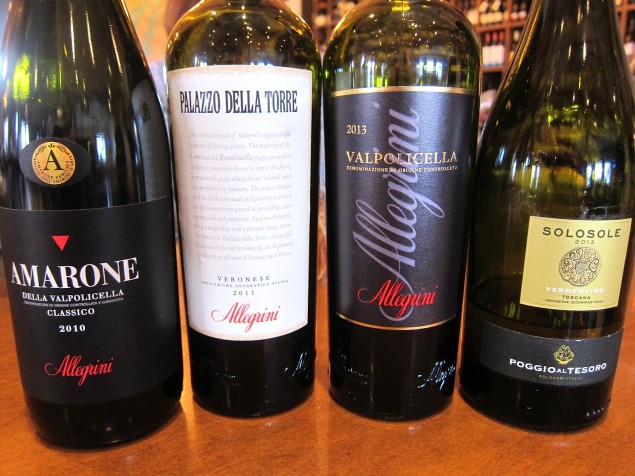Fifth generation Veneti winemaker, Giovanni Allegrini, grew up with a deep passion and pride for his roots and the place he was from. Growing up in the Valpolicella, a region that boasts over 500 years of wine production in the northeast part of Italy near Verona, Giovanni knew that the wines could be finessed, taking them from being good, to being truly great.

Earlier this week I met with Giovanni’s daughter, Allegrini Estates CEO and global representative Marilisa Allegrini, for lunch in Dallas, as her guest, to hear more about her father’s legacy, the work she and her brother, Allegrini winemaker Franco Allegrini, continue to do, and of course, taste the beautiful wines of Allegrini.
One of the most awarded DOCG Amarone della Volpolicella Classico in Veneto, Allegrini reached that prominence thanks to the work of Marilisa’s father. In the early 1970’s Giovanni Allegrini changed the basic farming techniques for Valpolicella, eventually leading to a change in Amarone production with the help of her brother.
A little history on the region and the wine. Though the region is not located near the sea, the region of Valpolicella benefits from a Mediterranean like microclimate thanks to the influence of Lake Garda bordering its western boundary with constant, warming breezes coming off the lake. The vineyards are also blocked from cold winds coming down from the Italian Alps by the Lessini Mountains on the northern boarder. This helps create an atmosphere with very warm days and cool nights, allowing fruit to ripen in the summertime, while keeping acidity bright. This is the ideal place to grow grapes.
However, for centuries, the wine growing process followed traditional methods that did not always produce well rounded flavors with complexity or character. Like many wine regions in the world, the three main grapes varieties of the region (Corvina, Rondinella and Molinara) were grown using pergola trellising, often on the valley floors of the region. This allowed for other vegetables, like potatoes, corn, greens, to be grown by viticulturists underneath the vines. This method works well in some areas, like Rias Baixas, where Albarino can fully ripen near the sun thanks to the vine training of the pergola. However, for the varieties in Valpolicella, this wasn’t the case, with Corvina in particular benefiting from growth closer to the ground.
Marilisa noted that in the 1970’s Giovanni Allegrini challenged these traditional wine growing practices, changing to a double Guyot trellis training with site specific varietal planting, increasing plant density per acre, while often moving vineyards higher onto the hillsides, up to the highest elevation of the region (around 1500 feet above sea level,) instead of on the nutrient rich valley floors that are needed to grow crops but a hinderance in growing vines. This method required vines to struggle more, driving roots deep into the group to find nutrients, while being in an excellent position on sloping hillsides to receive the suns ripening rays. This practice created complex, highly concentrated fruit, particularly with the thick skinned Corvina. Time also allowed for varieties that didn’t add as much to the wine, like the rather un-structured, light colored Molinara, to be phased out from the production process, and varieties like Corvinone (similar in phenolic characteristics to those of Corvina Veronese) and Oseleta (a robust, highly flavorful, spicy variety with structure) to be planted in the region, along with minor plantings of other varieties like Sangiovese. These practices revolutionized the quality for Valpolicella, which opened the door for winemaker Franco Allegrini to modernize the production of Amarone.
 Franco refined the traditional ripasso technique, which passes fresh wine over grape pomace creating a wine with dried, raisin-like, often bitter characteristics, to the delicate, grape-drying process known as “appassimento,” which means drying before pressing in Italian. With appassimento selected bunches of Valpolicella grapes, harvested at the height of ripeness between late September and early October, are laid out in crates and left to dry in well-ventilated facilities with high humidity for 100 to 120 days, creating a natural environment and prevent mold. During this period the fruit loses between 40% or more of their original weight and becomes very concentrated, undergoing a complex chemical transformation creating a velvety texture and rich aromas in the raisiny grapes.
Franco refined the traditional ripasso technique, which passes fresh wine over grape pomace creating a wine with dried, raisin-like, often bitter characteristics, to the delicate, grape-drying process known as “appassimento,” which means drying before pressing in Italian. With appassimento selected bunches of Valpolicella grapes, harvested at the height of ripeness between late September and early October, are laid out in crates and left to dry in well-ventilated facilities with high humidity for 100 to 120 days, creating a natural environment and prevent mold. During this period the fruit loses between 40% or more of their original weight and becomes very concentrated, undergoing a complex chemical transformation creating a velvety texture and rich aromas in the raisiny grapes.
This process creates an elegant, rich and luscious wine with depth and character. Though the overall yield is smaller than in the traditional ripasso practice, the resulting wine has greater depth, richness and quality. In 2014 the family won their 30th Tre Bicchieri (“Three Glasses”) award from Italy’s Gambero Rosso, of which their Amarone has won 16, more than any other Amarone in the region. Tasting the 2010 vintage of the Allegrini Amarone it is surprising how delicate the flavors are. Though the dried raisiny characteristics are present, there is a softness and freshness to the wine, blended with inherent complexity, not often found in young Amarone. Often Amarone wines will have a slight bitterness, as the name means in Italian “the great bitter” or sweet port-like characteristic. Happily, this has neither. Though high in alcohol (almost 16%) the refined wine maintains a lightness thanks to balanced acidity and well integrated tannins with spice, dried fruit and ripe cherry notes. (Suggested retail price $85)
 They also focussed heavily on single vineyard wine production, as is evident in their Palazzo della Torre IGT wine from limestone and clay filled vineyards surrounding their Renaissance era estate, Villa della Torre. Made in a process similar to the traditional ripasso method, however incorporating fruit from the high quality appassimento process of Amarone instead of using pomace. Palazzo della Torre is made with a small percentage of specially selected fruit, left out to dry between harvest and December.
They also focussed heavily on single vineyard wine production, as is evident in their Palazzo della Torre IGT wine from limestone and clay filled vineyards surrounding their Renaissance era estate, Villa della Torre. Made in a process similar to the traditional ripasso method, however incorporating fruit from the high quality appassimento process of Amarone instead of using pomace. Palazzo della Torre is made with a small percentage of specially selected fruit, left out to dry between harvest and December.
This then goes through a “double fermentation” method where fresh vinified Corvina, Rondinella and a touch of Sangiovese gently passes over the crushed semi-dried grapes, starting a second fermentation. The wine has an earthiness and mineralic character that leaps from the glass, melding with ripe fruit, tobacco and spice characteristics. Complex, layered and robust, defining the region in the glass. Pairings for either of these wines could range from grilled beef, venison and lamb to freshly made, egg noodle pasta with a rich sauce to a hearty risotto, often seen on tables throughout the region. Marilisa’s favorite though would be Peking Duck as it enhances the dried fruit, spice and earthy characteristics in the wine. (SRP $30)
Finding success in Veneto, the family looked west to the Bolgheri region in Tuscany to continue their exploration of producing great wines of Italy. Marilisa, Franco and their later brother, Walter, founded the Poggio al Tesoro estate. Keeping with the desire to focus on single vineyard wines the family identified the estate was perfect for growing Vermentino. Sand, gravel and clay soils are ideal for the variety and the vineyard’s close proximity to the sea ensures an inherent brininess to evolve as the wine develops. However, the family didn’t look to Sardinia for the best clones of Vermentino, even though the island is one of the best places to grow the grape, or north to Piemonte, they found a Vermentino clone from Corsica that was better suited for their terroir, planting 17 acres of vines.
Poggio al Tesoro Solosole Vermentino captures the essence of the region, with spring flowers, golden apple, juicy citrus and melon notes. Rich and textured, yet also light and fresh thanks to balanced acidity, making it a white that has the ability to age for several years, evolving over time. Marilisa noted that this clone, grown in their soils, creates an almost petrol characteristic in the wine after some time aging in the bottle, similar to a quality Riesling, making it an ideal food wine, to be served with anything from fish to pork to poultry. (SRP $24)
In talking with Marilisa about the future of her family and the company, she notes that it is an exciting time as her two daughters and Franco’s son are interested, though not fully engaged yet. With the history of the family, and the constant innovation and breaking with the tradition, and the development in new regions it is easy to understand why the Allegrini family continues to rise to the top, leading the way among the most respected producers in Italy. The red wines are available locally at Spec’s and Goody-Goody stores.





